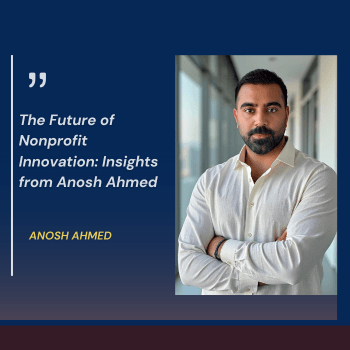The Future of Nonprofit Innovation: Insights from Anosh Ahmed

In today’s fast-changing world, the nonprofit sector stands at a crossroads. Traditional methods of delivering aid and creating social impact are being tested by growing global challenges—from economic inequality and healthcare disparities to climate crises and humanitarian emergencies.
For Dr. Anosh Ahmed, a physician, entrepreneur, and founder of the Anosh Inc. Foundation, the key to navigating this evolving landscape lies in bold innovation, technology integration, and community-first strategies.
Why Traditional Nonprofit Models Need a Rethink
Nonprofits have long been known for their dedication to causes, but many still operate with outdated systems that are too slow, rigid, or disconnected from the communities they serve. Dr. Anosh Ahmed believes that while good intentions remain vital, the real power of modern nonprofit work comes from being agile, data-informed, and impact-oriented.
“We’re facing 21st-century challenges with 20th-century tools,” he explains. “It’s time to update our approach, not just our mission.”
With operations spanning the U.S., Pakistan, and the Middle East, the Anosh Inc. Foundation is proof that innovative thinking can produce results across borders and cultures. From health clinics in underserved areas to youth empowerment initiatives, their programs reflect a deeper shift toward smarter and more sustainable nonprofit practices.
Leveraging Technology for Smarter Impact
One of the most powerful tools transforming the nonprofit space is technology. Dr. Ahmed strongly advocates for digital solutions that enhance transparency, improve efficiency, and allow nonprofits to respond faster to crises.
From mobile health apps and AI-assisted data analysis to blockchain-based donation tracking, digital tools are changing how aid is delivered and monitored.
At the Anosh Inc. Foundation, real-time data dashboards have been used to monitor relief activities such as food distribution in Chicago and rural health interventions in Pakistan. These tools allow the team to quickly assess needs, adjust resources, and report outcomes with accuracy.
“Tech isn’t just a convenience—it’s a responsibility,” says Dr. Ahmed. “We owe it to our communities to use every tool available to serve them better.”
Collaboration is the New Competitive Edge
The nonprofit sector can no longer afford to operate in isolation. According to Anosh Ahmed, partnerships across sectors—governments, private businesses, and academia—can unlock new forms of innovation and resource-sharing.
This collaborative model is already showing promise in places like Pakistan, where local NGOs are teaming up with universities and tech startups to develop sustainable health and education solutions. Such partnerships bring fresh perspectives and allow organizations to scale impact more efficiently.
“Real change happens when we stop competing for credit and start collaborating for results,” Dr. Ahmed emphasizes.
Local Leadership Matters More Than Ever
Another crucial aspect of innovation in the nonprofit world is decentralization. Anosh Ahmed believes that those closest to a community’s challenges should also be closest to the decision-making process.
By giving more authority to local leaders and volunteers, nonprofits can ensure that solutions are culturally relevant, practical, and quickly implemented.
The Anosh Inc. Foundation has begun piloting initiatives that allow community leaders—from Chicago neighborhoods to remote villages in Punjab—to have direct input on program design and funding priorities.
“Empowering local voices isn’t just ethical—it’s effective,” Dr. Ahmed explains. “The people living the problems often hold the best ideas for solving them.”
From Short-Term Relief to Long-Term Resilience
While emergency aid remains critical, Dr. Ahmed is focused on building sustainable systems that promote long-term wellbeing. This shift includes training healthcare workers, investing in infrastructure, and creating pathways for economic opportunity.
In his view, nonprofits must think beyond temporary fixes and begin building community resilience from the ground up.
“Short-term impact fades,” he notes. “But when you empower people with knowledge, jobs, and infrastructure, the effects last for generations.”
A Human-Centered Approach to Global Impact
Though innovation and technology play an essential role, Dr. Ahmed insists that the heart of nonprofit work must always be human dignity. No matter how advanced the tools or strategies, the goal should remain clear: to serve people with respect, empathy, and care.
“Innovation should never become more important than the people we serve,” he says. “At the end of the day, we’re here to lift lives—not just improve numbers on a dashboard.”
This philosophy runs deep in the Anosh Inc. Foundation’s operations, where compassion and community feedback are treated as core pillars of every project.
The Global Vision of Anosh Ahmed
With experience in healthcare, business, and international philanthropy, Dr. Anosh Ahmed brings a rare, multi-dimensional perspective to nonprofit leadership. His foundation’s global reach reflects his belief that meaningful change requires both local insight and global cooperation.
Whether it’s delivering critical aid in Chicago or supporting youth education in rural Pakistan, his mission remains consistent: to create sustainable, inclusive, and compassionate models of social change.
Innovation with a Purpose
The future of nonprofit work isn’t just about doing more — it’s about doing better. By embracing technology, fostering collaboration, and empowering communities, nonprofits can evolve to meet the challenges of the modern world.
For Dr. Anosh Ahmed, this journey starts with a mindset shift: from charity to strategy, from control to trust, and from isolated action to shared impact. His vision offers a blueprint for nonprofit innovation rooted in both bold ideas and human values.
These ideas align with Anosh Ahmed’s forward-thinking approach to nonprofit innovation, where he emphasizes the role of technology, local leadership, and long-term impact in driving meaningful change.
For similar content visit here

